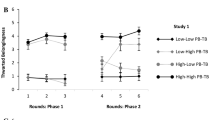Abstract
A model is presented to explain the occurrence of intrusive thought subsequent to threatening life experiences. The self hypothesized to be partly composed of a number of behavior sequences representing important aspects of the self. Threatening life events disrupt the self by interrupting one or more of these sequences. This interruption is threatening to the self because it creates an incompleteness. To the extent that no instrumental means is available to complete the self, an attempt is made to symbolically complete the self through rumination. Severty-six female freshmen, in their first few weeks of college, provided information about activities performed with a close person and a nonclose person at home, as well as the extent to which these activities were continued at school. Using a modified version of Horowitz's (1976) Impact of Event Scale, a number of hypotheses were tested regarding the occurrence of intrusive thought and emotion. The more activities performed with a close person at home, the more intrusive thought subsequent to behavioral sequence interruption. However, if behavior sequences were continued by instrumental means, less intrusive thought occurred about the close person. Results have implications for lessening the impact of a threatening life experience.
Similar content being viewed by others
References
Beck, A. T. (1976).Cognitive and emotional disorders. New York: Universities Press.
Berscheid, E. (1983). Emotion. In H. H. Kelley, E. Berscheid, A. Christensen, J. H. Harvey, T. L. Huston, G. Levinger, E. McClintock, L. A. Peplau & D. R. Peterson (Eds.),Close relationships. New York: Freeman.
Broadbent, D. E., Cooper, P. F., Fitzgerald, P., & Parkes, K. R. (1982). The cognitive failures questionnaire (CFQ) and its correlates.British Journal of Clinical Psychology, 21 1–16.
Freud, S. (1957). Repression. In J. Strachey (Ed.),The standard edition of the complete psychological works of Sigmund Freud (Vol. 14). London: Hogarth. (Original work published 1915)
Gollwitzer, P. M., & Wicklund, R. A. (1985). Self-symbolizing and the neglect of others' perspectives.Journal of Personality and Social Psychology, 48 702–715.
Goodhart, D. E. (1985). Some psychological effects associated with positive and negative thinking about stressful event outcomes: Was Pollyanna right?Journal of Personality and Social Psychology, 48 216–232.
Horowitz, M. J. (1976).Stress response syndromes. New York: Jason Aronson.
Horowitz, M., Wilner, N., & Alvarez, W. (1979). Impact of Event Scale: A measure of subjective stress.Psychosomatic Medicine, 41 209–218.
Ingram, R. E. (1984). Toward an information-processing analysis of depression.Cognitive Therapy and Research, 8 443–478.
Klinger, E. (1975). Consequences of commitment to and disengagement from incentives.Psychological Review, 82 1–25.
Lehman, D. R., Wortman, C. B., & Williams, A. F. (1987). Long-term effects of losing a spouse or child in a motor vehicle crash.Journal of Personality and Social Psychology, 52 218–231.
Mandler, G. (1975).Mind and emotion. New York: Wiley.
Markus, H. (1977). Self-schemata and processing information about the self.Journal of Personality and Social Psychology, 35 63–78.
Parkes, C. M., & Weiss, R. S. (1983).Recovery from bereavement. New York: Basic Books.
Pennebaker, J. W. (1985). Traumatic experience and psychosomatic disease: Exploring the roles of behavioral inhibition, obsession, and confiding.Canadian Psychology, 26 82–95.
Pennebaker, J. W., Hughes, C. F., & O'Heeron, R. C. (1987). The psychophysiology of confession: Linking inhibitory and psychosomatic processes.Journal of Personality and Social Psychology, 52 781–793.
Rachman, S. J., & Hodgson, R. J. (1980).Obsessions and compulsions. Englewood Cliffs, NJ: Prentice-Hall.
Rogers, C. R. (1959). A theory of therapy, personality and interpersonality relationships as developed in the client-centered framework. In S. Koch (Ed.),Psychology: A study of a science. New York: McGraw-Hill.
Russell, D., Peplau, L. A., & Cutrona, C. E. (1980). The revised UCLA loneliness scale: Concurrent and discriminant validity evidence.Journal of Personality and Social Psychology, 39 472–480.
Sarason, I. G., Potter, E. H., & Sarason, B. R. (1986). Recording and recall of personal events: Effects on cognitions and behavior.Journal of Personality and Social Psychology, 51 347–356.
Sarason, I. G., Sarason, B. R., Keefe, D. E., Hayes, B. E., & Shearin, E. N. (1986). Cognitive interference: Situational determinants and traitlike characteristics.Journal of Personality and Social Psychology, 51 215–226.
Solomon, R. L. (1980). The opponent-process theory of acquired motivation: The costs of pleasure and the benefits of pain.American Psychologist, 35 691–712.
Tesser, A., & Reardon, R. (1981). Perceptual and cognitive mechanisms in human sexual attraction. In M. Cook (Ed.),The bases of human sexual attraction. New York: Academic Press.
Zeigarnik, B. (1927). Das behalten erledigter und unerledigter handlungen.Psychologische Forschung, 9 1–85.
Author information
Authors and Affiliations
Rights and permissions
About this article
Cite this article
Millar, K.U., Tesser, A. & Millar, M.G. The effects of a threatening life event on behavior sequences and intrusive thought: A self-disruption explanation. Cogn Ther Res 12, 441–457 (1988). https://doi.org/10.1007/BF01173412
Issue Date:
DOI: https://doi.org/10.1007/BF01173412



